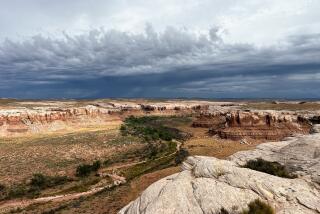A Bigger Wilderness Jewel
In light of the Bush administration’s increasing hostility to the environment, including its move Wednesday to roll back wildlife safeguards in the national forest system, congressional passage of a bill to add wilderness protection to nearly 55,000 acres of the Big Sur coast in Central California is a happy surprise. But the job will not be finished until President Bush signs HR 4750, the Big Sur Wilderness and Conservation Act of 2002. He should follow the example of his father, who as president signed into law earlier Big Sur protection.
The bill, by Rep. Sam Farr (D-Carmel), adds 10 parcels totaling about 37,000 acres to the Ventana Wilderness and two of 17,000 acres to the Silver Peak Wilderness, both in the Los Padres National Forest, and one small tract to wilderness in the Pinnacles National Monument south and east of Salinas. The land already is publicly owned.
The measure provides added protection to rugged and bountiful regions that include habitat for the California condor, the mountain lion and endangered steelhead trout. Under the Wilderness Act of 1964, these areas would become permanently off-limits to motorized travel and permanent structures. But they would remain open to hiking, camping, fishing and horseback riding.
The Big Sur additions had been included in Sen. Barbara Boxer’s (D-Calif.) proposed California Wild Heritage Act, which would add more than 2 million acres of wilderness in the state. But they were moved as separate legislation that had a better chance of passage. The huge Boxer measure will be far more controversial than Farr’s.
Farr carefully lined up support in his district for his Big Sur bill. Boxer and Sen. Dianne Feinstein (D-Calif.) worked to get Farr’s measure through the Senate shortly before Congress adjourned for the year. Prospects for Boxer’s bill dimmed with the swing to Republican control of the Senate in the Nov. 5 election. GOP senators who control critical committees have been generally hostile to ambitious wilderness measures.
Of the 45 million federally owned acres in California, about 14 million are classified as wilderness, ranging from foggy Humboldt County in the north to desert lands along the Mexican border and from the central and north coasts to the spine of the Sierra and eastward through the Mojave.
As a whole, the California wilderness contains the most varied geography in the nation, including Mt. Whitney, at 14,495 feet the highest point in the lower 48 states, and Death Valley, 282 feet below sea level. Much more deserves protection from increasing population and development. For now, however, Bush can add a few small jewels to California’s lovely diadem of wilderness.
More to Read
Sign up for Essential California
The most important California stories and recommendations in your inbox every morning.
You may occasionally receive promotional content from the Los Angeles Times.










